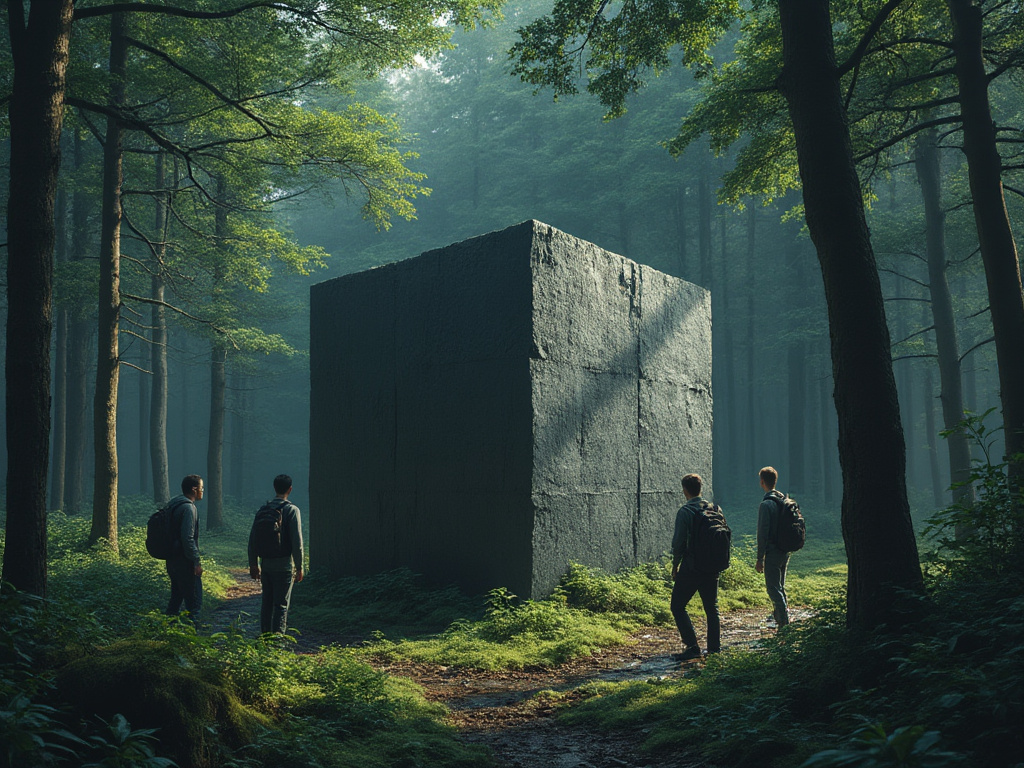
The Mithraic Ladder
The Mithraic Ladder is an occult concept referring to a ladder of seven steps. This ladder is not a physical object, but something that exists in the World of Forms. To climb the Mithraic Ladder is to perfect oneself spiritually. Thus, climbing higher involves going through a number of spiritual transformations. Symbolically, this ascent represents a return to God, to fully harmonise with the will of the Tao.
The Ladder of Mithras was a concept from the Mithraic Mysteries, a mystery school of ancient Persia. The Roman Empire stretched as far as Persia during the time of Trajan, and some of the Persian gods were syncretised into the Roman pantheon. By the time of the Late Empire, many legionnaires had been initiated into the Mithraic Mysteries and were followers of Mithra.
Initiation into the Mithraic Mysteries involved a series of seven degrees, wherein the candidate was subjected to a number of ordeals, with each ordeal somehow related to the degree in question. Precise knowledge of the true nature of each ordeal has been lost, but it is known that each one had an alchemical correspondence.
Symbolically, the Mithraic Ladder can be understood as the entire spectrum between good and bad, arranged vertically and then divided into seven steps, such that the bottommost step was the most bad and the topmost step the most good. These seven steps represent ascension through the degrees of the Mithraic Ladder.
The Mithraic Ladder is very similar to what an Elementalist would call the Great Masculine Axis. This is because it is in the nature of the masculine to divide between good and bad (as opposed to the nature of the feminine, which is to divide between masculine and feminine). It’s a line that runs directly upwards.
The seven steps of the Mithraic Ladder are roughly equivalent to the seven chakras in Vedic philosophy. As such, the process of rising up the Mithraic Ladder is similar to a kundalini awakening. Because this book is written primarily for a Western audience, it uses primarily Western esoteric terms to describe this process. Thus, the seven steps, from lowest to highest, are named in this book after the seven alchemical metals: lead, tin, iron, copper, silver, mercury and gold.
The level of spiritual development of any person – whether real or fictional – could be described as a position on the Mithraic Ladder. The bottommost step represents an undeveloped person, still an animal. The uppermost step represents a spiritually perfected person. The five steps in between represent the intermediate stages.
The book makes the argument that the most interesting thing about the development of any character (in this context, we are talking about fictional characters, but much applies to real-life ones) is their spiritual development. As such, the plot of any story can be summarised as the protagonist’s efforts to climb the Mithraic Ladder – or to descend it, in the case of tragedies and anti-heroes.
The Hero’s Journey
The Hero’s Journey is the ultimate archetype of fictional stories.
The most complete description of the Hero’s Journey was made by Joseph Campbell, the American mythographer. Campbell, in his landmark Hero With A Thousand Faces, wrote “A hero ventures forth from the world of common day into a region of supernatural wonder: fabulous forces are there encountered and a decisive victory is won: the hero comes back from this mysterious adventure with the power to bestow boons on his fellow men”.
Campbell described the Hero’s Journey as the monomyth underpinning the heroic stories and folk tales of cultures all around the world and all throughout history. It’s the one basic template of a story that everyone seems to naturally take an interest in, whether old, young, male, female, educated, uneducated, black, white or anything else.
Campbell’s basic formula is separation-initiation-return. The hero begins the story in their ordinary world, where their ordinary life progresses as usual. Then, some event upsets the natural order of life. Usually there is an evil antagonist behind this event. The hero is then cast into the special world, where they undergo a number of trials. If they pass them, they are initiated into a higher order of being. Then they return to their ordinary world, transformed into a hero.
Over the course of an interesting story, the protagonist has to change – from an ordinary person into a hero. They have to develop, otherwise the author is writing pulp fiction. The term ‘Hero’s Journey’ describes the typical pattern of development. It can have up to 20 stages depending on how detailed a person wants to get.
In children’s stories, it’s acceptable for the protagonist to develop in crudely material ways. They gain a fortune, they kill the enemy commander, they rescue the princess. But the sort of person who keeps reading fiction into adulthood soon wants more from their literature. They want more subtle character development.
Sophisticated literature is more about the emotional, mental and spiritual journeys than about physical ones. Readers want characters who change, who become permanently transformed by the trials they have undergone. What they want is a relatable Hero’s Journey that appeals to them on a deep level.
In a complete story written for modern audiences, the plot will be more complicated than separation-initiation-return. There will be multiple separations and initiations, and multiple false returns. The tripartite nature of the monomyth doesn’t change, however. The general pattern can be thought of as a descent down the Mithraic Ladder, then a spiritual transformation, then an ascent back up.
The contention made by this book is that this Hero’s Journey is most interesting if it’s considered in alchemical terms. Thus it is changes in a character’s frequency of consciousness over time that primarily makes a story interesting to a sophisticated, intelligent reader.
Alchemy
Alchemy is defined in this book as the process by which a person goes up or down the Mithraic Ladder. It has nothing to do with the transmutation of anything physical into anything else physical – it’s all about spiritual transformations. As such, there are two major types of alchemy: anabatic and katabatic.
Anabatic alchemy is the process of increasing one’s frequency of consciousness and ascending the Mithraic Ladder.
The ordeals of the early stages of this process only require small efforts, but they must be diligently repeated. Once the process is underway, greater efforts must be made to progress further, but with less emphasis on repetition. The process is finalised by a few acts of immense will.
This is what is typically referred to as the alchemical process. Spiritual lead is made into spiritual gold through a series of six refinements: enlarging, hardening, colouring, brightening, quickening and perfecting. This process is discussed in detail in the six chapters under the ‘Anabasis’ heading.
Katabatic alchemy is the process of decreasing one’s frequency of consciousness and descending the Mithraic Ladder.
As with anabatic alchemy, the process of katabasis begins with a large quantity of actions of individually low impact, and ends with major acts of high impact. The essential difference is that acts of katabatic alchemy are bad ones, increasing the suffering and misery in the world. Thus, spiritual gold is made into spiritual lead by a series of six defilements: imperfecting, retarding, dullening, discolouring, softening and shrinking. These stages comprise the six chapters under the ‘Katabasis’ heading.
This reverse alchemical process is not generally considered to be alchemical or heroic, but the fact is that before any character can rise to perfection, they must have first fallen out of it. As Carl Jung wrote “No tree, it is said, can grow to heaven unless its roots reach down to hell.” Any character can be made more realistic and easier to identify with if they have a bit of a dark side. Also, katabatic alchemy can help expand your antagonist’s back story, letting the reader know how they became that way.
The alchemical maxim solve et coagula, is very much like separation and return. This is closely analogous to the katabatic and anabatic stages of the alchemical process. The idea is to break apart one’s consciousness and then build it back stronger, like an athlete breaks apart his muscles in order to grow them.
The initiation phase, which occurs outside, between and beyond katabasis and anabasis, is where the real magic is. This initiation phase, in alchemical terms, is where the real magic of the fictional story happens, where katabatic energy is transformed into anabatic energy, and a character begins to ascend the Mithraic Ladder again.
At least in theory: a real story plot will be far more complex than this. In practice, a character attempting to rise up the Mithraic Ladder will encounter numerous obstacles, reversals, challenges and setbacks that will knock them back down a level or two. Betrayals and unexpected events might demand a temporary step down the Mithraic Ladder in order to get business done.
The Alchemy of Character Development
Understanding the Mithraic Ladder, the Hero’s Journey and alchemy, the reader of this book will understand the essential nature of excellent literature. The alchemy of character development is the storytime magic that causes your fictional characters to transform from one spiritual level to the next.
Almost everyone can relate to the basic struggle of wanting to be good but sometimes being bad out of weakness. Even young children understand the basic challenge of temptation to do things that aren’t in their long-term interest. This is why so many intriguing stories are based around temptation and moral dilemmas (for more on this specific topic, see Book 3 in this series, 16 Moral Dilemmas).
In alchemical terms, this is the struggle of wanting to rise up the Mithraic Ladder. The desire to rise up and reunite with divinity is understood by people everywhere. Mature readers will also understand that there is a dark side to the human being, something that drives them down the Mithraic Ladder, and that this is in conflict with the first force.
This alchemy is what makes fiction good, and what makes literature memorable.
The goal of this book is to describe, in the clearest terms, all the possible alchemical journeys that could be taken by a character in dramatic fiction. This description can be thought of as a series of archetypal templates of psychological transformation. How those transformations happen is explained in depth in each of the individual chapters.
This magic of alchemy, as described in this book, is not limited to the protagonist of your story. Minor characters that undergo the transformations described in this book will be much more interesting than static characters. So will antagonists that undergo katabatic processes. Even characters that are only described in passing can be made more interesting if their backstory is explicated in alchemical terms.
You can also use this book as a source of prompts by randomly choosing one of the twelve transformations described in the Anabasis and Katabasis sections, and using that as the basis for a story.
However this book is used, the information contained herein will deepen and broaden the reader’s understanding of the spiritual aspects of reality as well as the alchemical process.
*
This is an excerpt from Vince McLeod’s The Alchemy of Character Development, the sixth book in VJM Publishing’s Writing With Psychology series. This book will show you how to use alchemy to create deep, realistic and engaging characters for your creative fiction.
*
For more of VJM’s ideas, see his work on other platforms!
For even more of VJM’s ideas, buy one of his books!
*
If you would like to support our work in other ways, make a donation to our Paypal! Even better, buy any one of our books!







